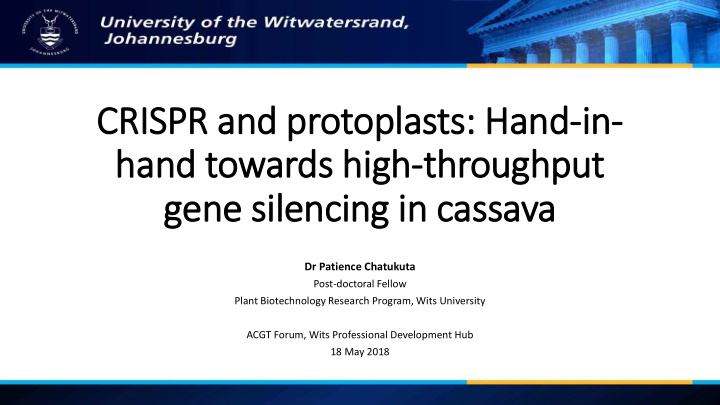



CRI RISPR a R and prot otop oplasts: Ha Hand-in in- hand towards h high-thr hroughput hput gen ene s silenci cing in c n cassa assava Dr Patience Chatukuta Post-doctoral Fellow Plant Biotechnology Research Program, Wits University ACGT Forum, Wits Professional Development Hub 18 May 2018
Importance of cassava 1. Food security crop in Southern Africa 2. Source of starch for industrial purposes B A A. Intercropping of cassava and maize. B. Distribution of global consumption of cassava
Cassava Ge Geminivi viruses es • Geographical distribution of cassava-infecting geminiviruses
Gene silencing in functi tional genomics • Different approaches are currently being used to broadly assign functions to unknown genes • Reverse genetics approaches have been used to disrupt genes and create loss-of-function mutants • The CRISPR/Cas9 system is one of the more recently developed tools that can be harnessed to silence targeted genes with high specificity, easy manipulation, high efficiency and high throughput • This has been proven in Arabidopsis, wheat, rice, among others
Gene silencing in cassava • Cassava is recalcitrant to transformation; existing methods are time-consuming • Current methods for evaluating gene function in cassava are lengthy, space inefficient, require frequent assessment of plants by skilled personnel • Several recent reports detail new approaches such as virus-induced gene silencing, RNA interference via viral antisense RNAs and siRNAs, and genome editing using CRISPR/Cas9 • Agrobacterium -mediated delivery of CRISPR/Cas9 has been used to silence the phytoene desaturase ( MePDS ) gene, study cassava brown streak disease by silencing the translation initiation factor 4E (eIF4E), to silence the viral AC2 and AC3 genes involved in gene activation and replication enhancement respectively • These involved generation of whole transformed plants, a process which takes at least 8 months • The use of protoplasts provides a rapid in vivo route of assaying the effects of gene silencing
Me Method
Prelimi minary bioi oinfor ormatic analysis of t target gene Manes.12G069400: • Belongs to the RING/U-box superfamily • Is co-expressed with a ubiquitin-protein complex adapter and various binding proteins • Involved in the biotic and abiotic stress response of cassava • Involved in the ubiquitination process which (a) modulates protein function (b) is reprogrammed by geminiviruses to achieve full host infection • Involved in selective, non-covalent interaction with zinc ions and other proteins/protein complexes • Up-regulated in SACMV-infected TME3, according to transcriptome data (unpublished data) • One of 105 genes annotated as candidates for association with CMD resistance
Recombinant C Cas9 plasmid constru ruction gRNA Cas9
Ge Genom omic gRNA NA ta targ rget identification
gRNA NA design
Pl Plant Growth th B A Growth of cv.60444, T200 and TME3 cassava cultivars. A. Nodal cultures. B. One month-old plants.
Protoplast t Isolati tion A B C Cassava protoplasts under bright field microscopy at 40X. A. cv.60444 B. T200 C. TME3
Protoplast Quantifi fication Flow cytometric quantification of released cassava protoplasts. A02. cv.60444 A03. T200 A04. TME3
Protoplast t Viability A Assay Fluorescein diacetate staining of 48h-old cassava TME3 protoplasts. Protoplasts viewed using fluorescence microscopy at 40X. A. Green filter image. B.. Bright field and green filter image.
Prot otop oplast Transfor ormation on Assay B A Fluorescent cv.60444 protoplasts viewed using fluorescence microscopy at 100X. A. eGFP filter image. B. Bright field and eGFP filter composite image.
Amplification of target region transcript bp UT V C VC UT V C VC UT V C VC 400 200 TME3 cv60444 T200
To o do o list 1. Detect and quantify efficiency of targeted mutagenesis in transformed protoplasts 2. Conduct transient expression assays of transformed protoplasts 3. Conduct deep sequencing of edited genomic target region 4. Silence more genes implicated in cassava-SACMV interactions to assist in creation of functional networks
References patience.chatukuta@wits.ac.za patience.chatukuta@gmail.com
ACKNOWLEDGEMENTS • Prof Rey • Plant Biotech Research team • National Research Foundation
END ND
Recommend
More recommend